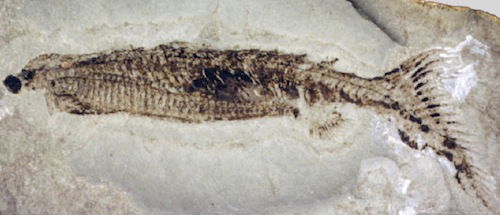
Did Paired Fins Foreshadow Paired Limbs in Terrestrial Animals?
Fish fins appear paired too early in the fossil record.
News Source
A jawless fish from Devonian rock has paired fins where even modern fish do not. Evolutionists, like The Incredible Mr. Limpet of movie fame, believe fish evolved into terrestrial vertebrates and eventually into us. Though now forced to slightly rework their ideas about the sequence of events, they suggest that we can thank this early jawless fish’s experimentation for the fact that we have right and left versions of our arms and legs.
Euphanerops longaevus fossils from Quebec’s Miguasha National Park are from rock layers conventionally dated at 370 million years. Evolutionists believe this is the time that jawless and jawed fish diverged from a common evolutionary ancestor. They believe the latter, the jawed fish, were the evolutionary ancestors of modern terrestrial vertebrates such as humans.
Paired fins—pectoral fins and pelvic fins—are generally thought by evolutionists to be the predecessors of vertebrate legs. But neither extinct nor modern jawed fish have paired anal fins. Therefore, though they don’t know what purpose the pairing of the anal fins served, they conclude that Euphanerops represents a bit of evolutionary trial and error, trying out a different location for paired appendages.
“Euphanerops is unique because its anal fin is paired, meaning there is one fin on each side of the fish. Up until now anal fins have only been seen on jawed fish where they are unpaired, and this is true of both extinct and modern fish,” says paleontologist Robert Sansom, co-author of a paper in Biology Letters. “The age of Euphanerops is important as it dates from the time of a deep evolutionary split between jawed and jawless fish, the two main divisions of vertebrates alive today. As such, it represents an important stage in the evolution of paired appendages.”

Fossils of this jawless fish, Euphanerops, were found in the Devonian rock of Quebec’s Miguasha fossil site in 1900. Three-dimensional scans have confirmed the presence of an unusual paired anal fin. Evolutionists assert the paired fins of uncertain use were an evolutionary experiment foreshadowing the development of paired limbs in terrestrial animal. Image by Robert S. Sansom et al./Biology Letters, Postmedia News through calgaryherald.com.
Euphanerops was discovered in 1900 and noted to have an unusual anal fin. But the fact that these flattened fossils actually have paired anal fins was unsuspected until the British team of investigators subjected 36 of the fish to 3D scans.
“It’s not clear why the fins are positioned so far back on the fish, or what advantage they might have provided. However, they do show that our early vertebrate ancestors tried out lots of different body plans before settling on two arms and two legs. If they hadn’t, then our bodies would have looked very different,” explains Sansom.
“Rather than gradual acquisition of complex characteristics, maybe there was a bit more experimentation and odd acquisitions,”1 Sansom explains. He says this exciting discovery “lends support to the idea that there was some degree of developmental and evolutionary experimentation in some [Devonian] fish. The discovery of new anatomical conditions will hopefully shed more light on the timing and sequence of the events underlying the origin and diversification of vertebrate appendages.”
The predominance of marine organisms in deeper fossil layers . . . is explained by the global Flood.
While the three-dimensional imaging of this extinct jawless fish has indeed demonstrated more about the anatomical diversity of jawless fish, it has not—with all due respect to the memory of Don Knotts2—revealed anything about human ancestry. The predominance of marine organisms in deeper fossil layers (including the Devonian) is explained by the global Flood, the turbulence of which would have catastrophically buried billions of marine organisms in its early stages. The order of organisms in much of the fossil record reflects the order of burial during the global Flood. (See “Doesn’t the Order of Fossils in the Rock Record Favor Long Ages?” to learn more.)
The fossil record is not a record of millions of years of evolution; it also does not contain the transitional forms that evolutionary beliefs demand must exist. Furthermore, no observed mechanism in biology has demonstrated any way for the anatomy of fish to be transformed into the very different anatomy required for locomotion on land. (Read more about this in the articles mentioned below.)
God created all kinds of fish on the fifth day of Creation week, and each was able to reproduce after its kind. The very next day He created the land animals and man. God did not create terrestrial vertebrates through random or directed evolution, and we have His own eyewitness testimony about that time of origins in the Bible. God did all this about 6,000 years ago, a time easily gleaned from the interlocked years of the biblical genealogies. Observable science is consistent with God’s record of Creation and of the global Flood, the millions of years dates being derived from unverifiable untestable assumptions that are inconsistent with recorded history.
Further Reading
- Doesn’t the Order of Fossils in the Rock Record Favor Long Ages?
- Developments in Fish Said to Show How Limbs Evolved
- Lungfish Studied to Determine Transitional Evolution
- Leaping Fish Seen as a Successful Transitional Creature
- Tiktaalik and the Fishy Story of Walking Fish: Part 1, Part 2
- 3D Fossil Images Force Evolutionists to Revise Terrestrial Story
- The Fossil Record of ‘Early’ Tetrapods: Evidence of a Major Evolutionary Transition?
- Vestigial Salmon Organ Actually Useful
- Fish Still Considered a Transitional Form of Evolution
- Hands and Feet
- Vestigial Hiccups, Folding Fish-eyes, and Other Fables: Our Fishy Forebears . . . Again!
- Radiometric Dating: Back to Basics, Problems with the Assumptions, Making Sense of the Patterns
For More Information: Get Answers
Remember, if you see a news story that might merit some attention, let us know about it! (Note: if the story originates from the Associated Press, FOX News, MSNBC, the New York Times, or another major national media outlet, we will most likely have already heard about it.) And thanks to all of our readers who have submitted great news tips to us. If you didn’t catch all the latest News to Know, why not take a look to see what you’ve missed?
(Please note that links will take you directly to the source. Answers in Genesis is not responsible for content on the websites to which we refer. For more information, please see our Privacy Policy.)
Footnotes
- www.livescience.com/28590-bizarre-fish-sported-anal-fins.html
- Don Knotts portrayed Mr. Limpet in the classic 1964 Warner Brothers film The Incredible Mr. Limpet which depicts a man who dreamed of experiencing a reversal of evolution and becoming a fish.

Answers in Genesis is an apologetics ministry, dedicated to helping Christians defend their faith and proclaim the good news of Jesus Christ.
- Customer Service 800.778.3390
- Available Monday–Friday | 9 AM–5 PM ET
- © 2025 Answers in Genesis



